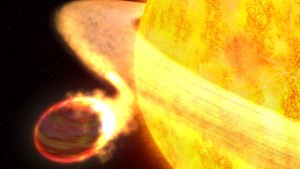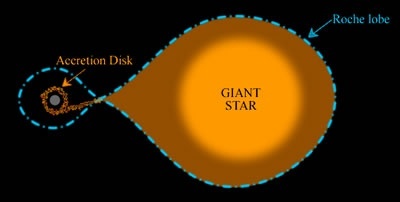
A hot Jupiter being ingested by its host star. From http://sen.com/thumbs/1024×576/img/47b3082d767346e8bebdb5ad99f8f33d.jpg.
Since astronomers have discovered hundreds of planets orbiting perilously close to their host stars over the last few decades, the question of what happens to planets when they wander too close to their host stars has intrigued astrophysicists.
These so-called close-in planets zip around their stars in just hours and are so close to their stars that the starlight heats their surfaces and atmospheres to thousands of degrees.
Since the planets’ atmospheres are so hot and puffy, the planets have only a tenuous gravitational hold on them, and some planets have been observed losing their atmospheres. I myself have made a hobby over the last few years of ripping apart exoplanets in the computer and of looking for their fossils in the sky.
How long it takes these hot Jupiters to lose their atmospheres and what’s leftover after the atmospheres are gone have been the subject of speculation for a while, and key to answering these questions is understanding what happens to the planets’ radii (and thus, their gravity) and what happens to the escaping mass.
A recent study by Shi Jia and Hendrik Spruit explores a new aspect of this Roche-lobe overflow process, and their results suggest the atmospheric disruption process might happen a lot faster than astronomers have thought.

Accretion disk formation for a binary star system.
Previously, it had been assumed that, as a planet’s atmosphere is ripped away, it goes streaming down toward the host star, and the gas then goes into its own orbit close to the star, forming what’s called an accretion disk. This process has been studied for decades in binary star systems, in which one star donates mass to their other.
This accretion disk can then interact gravitationally with the disrupting planet, pushing it back away from the star a bit and moderating the rate at which mass escapes from the planet.
The upshot of this is that formation of the accretion disk can slow the disruption process, and so it could take billions of years for a Jupiter-mass planet to lose its entire atmosphere – a long time on human timescales but relatively short on astronomical timescales.
However, in their study, Jia and Spruit point out that these hot Jupiters undergo disruption very close to their host stars – so close, in fact, that, between the planet and the stellar surface, there might not be room enough for an accretion disk to form at all. Instead, gas that escapes the planet might just crash directly into the host star.
That’s a problem for the planet because if there’s no disk around, it can’t slow the mass loss rate, and so the planet might shed its entire atmosphere not in billions of years but just a few weeks – less time than it would take me to explain the process during a semester of astrophysics class.
Although the disruption process might be very fast, Jia and Spruit’s results suggest the remnants might be left around to be observed. What exactly they look like is still unclear, but the K2 and upcoming TESS missions will probably find lots of them (and may already have).
